#allosaurus scavenger
Explore tagged Tumblr posts
Text

This is a replica claw from the large middle toe of an Allosaurus, from the Jurassic, around 156-130 million years ago. According to the paper that came with it when I bought it, the replica is of a specimen from the Morrison formation at the Cleveland-Lloyd Quarry in central Utah. This is the only piece of vulture culture that I purchased online.
Measuring from the tip of the claw to the furthest back part, it is about 5.5 inches (14 centimeters) long.
This claw was not used as a weapon for Allosaurus, but instead, being part of the foot, was for walking, and possibly holding down struggling prey or pinning a carcass in place as the animal ate a meal.
2 notes
·
View notes
Text
Patreon request for @/rome.and.stuff (Instagram handle) - Saurophaganax maximus

Saurophaganax maximus was an allosaurid from Late Jurassic Oklahoma, USA. Reaching 10.5 metres (34 ft) in length and weighing 2.7–3.8 metric tons (3.0–4.2 short tons), it was the largest terrestrial carnivore in North America during the Late Jurassic, bigger than both its contemporaries Torvosaurus tanneri and Allosaurus fragilis. Some scientists argue that it was in fact a species of Allosaurus (making it “Allosaurus maximus”), but possible Saurophaganax material found in New Mexico may shed light on the genus. With a name meaning "lord of lizard-eaters", it was likely the apex predator of its environment.

Found in the Brushy Basin member of the Morrison Formation, Saurophaganax would have had a multitude of prey species to choose from. These ranged from small ornithischians like Camptosaurus, Dryosaurus, and Fruitadens, armoured thyreophorans like Gargoyleosaurus, Mymoorapelta, Hesperosaurus, and Stegosaurus, to a diverse array of giant sauropods like Haplocanthosaurus, Amphicoelias, Apatosaurus, Brontosaurus, Barosaurus, Diplodocus, Kaatedocus, Supersaurus, Brachiosaurus, and Camarasaurus. Small theropods included Coelurus, Hesperornithoides, Tanycolagreus, and Ornitholestes.
The Morrison didn’t only have a large diversity of dinosaurs. Many pseudosuchians lived alongside Saurophaganax, from the skittering, long-legged Hallopus to the more aquatic Amphicotylus. Pterosaurs were uncommon but widespread, and included rhamphorhynchids like Harpactognathus and ctenochasmatids like Kepodactylus. Other reptiles like rhynchocephalians, lizards, basal snakes, and turtles were common as well. Many cynodonts, mostly early mammals, also called the Morrison home.
The Morrison Formation was also rife with other large predators that could have been either competitors or prey to Saurophaganax themselves. These include the previously mentioned Allosaurus and Torvosaurus, as well as the smaller Ceratosaurus nasicornis and Marshosaurus bicentesimus. As Allosaurus seemed to be the most numerous predators in this formation, they may have been successful pack hunters while Saurophaganax was more of a “lone wolf.” Its remains are much rarer than that of its smaller, lither cousins, and it was likely an opportunistic scavenger and hunter, needing much more food to power its larger frame.

This art may be used for educational purposes, with credit, but please contact me first for permission before using my art. I would like to know where and how it is being used. If you don’t have something to add that was not already addressed in this caption, please do not repost this art. Thank you!
#Saurophaganax maximus#Saurophaganax#allosaurid#allosauroid#theropods#saurischians#dinosaurs#archosaurs#archosauromorphs#reptiles#SaritaDrawsPalaeo#Morrison Formation#Late Jurassic#North America
16 notes
·
View notes
Text
Bite and tooth marks on sauropod dinosaurs from the Morrison Formation
Published 14th November 2023
Researchers survey fossil collections cataloging 68 sauropod bones from the Upper Jurassic Morrison Formation of the USA that bear bite traces that can be attributed to theropods, the observed bite traces show no signs of healing indicating predation or scavenger behaviour.
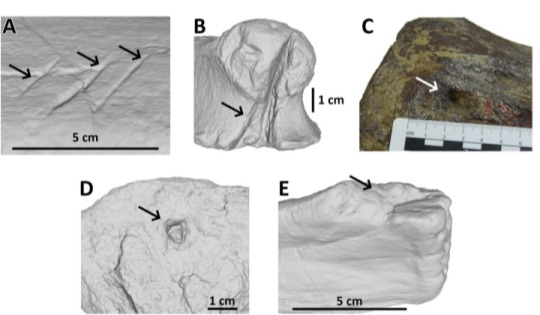
Examples of bite traces on Morrison Formation sauropod elements

Bite traces on a sauropod neural spine of Apatosaurus
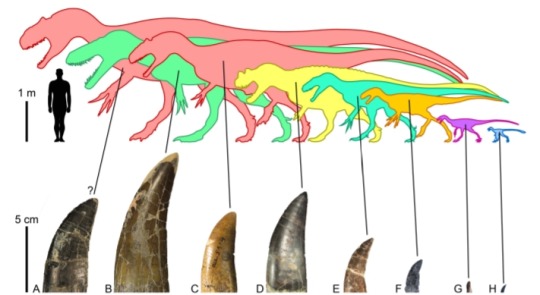
Morrison Formation theropods and their tooth crowns, (A)Allosaurus, (B)Torvosaurus tanneri, (C) Allosaurus, (D) Ceratosaurus, (E) Marshosaurus bicentessimus, (F)Tanycolagreus topwilsoni, (G)Ornitholestes hermanni, (H)Hesperornithoides miessleri
source:
30 notes
·
View notes
Text
Welcome to the Juras-Sick Park-Cast podcast, the Jurassic Park podcast about Michael Crichton's 1990 novel Jurassic Park, and also not about that, too.
Find the episode webpage at: Episode 40 - Control.
In this episode (stream it here!), my terrific guest Dr. W. Scott Persons IV joins the show to chat with me about:
field trips, othnielia vertebrae, splitting and lumping, The Lance Formation of Wyoming, nodosaurs, ichnofossils, ankylosaur osteoderms, hair-pulling and cringey moments in Jurassic Park, Nedry holding his own entrails, dinosaurs in media, The Land Before Time, incredible technology in the novel, like the fax machine!, studying dinosaur locomotion, the mighty caudofemoralis, comparative anatomy, running hadrosaurus and running tyrannosaurs, can T. rex run 40 mph?, reduced tyrannosaur arms, Yutyrannus arms, tails, spinosaurus tails, leaellynasaura tails, the evolution of feathers, looking for rictal bristles in super-primitive dinosaurs without feathers, injured allosaurus pubes, a detailed description of stegosaur tails, and much more!





Plus dinosaur news about:
The Double Dinosaur Brain Myth
Allosaurus Died From Stegosaur Spike to the Crotch, Wyoming Fossil Shows


Featuring the music of Snale https://snalerock.bandcamp.com/releases
Intro: Latebloomer. Outro: Grow Old Or Don't.

The Text:
This week’s text is Control, spanning from pages 218 – 220.Synopsis:
Harding, Sattler and Gennaro follow the compys through the park, but just as they’re about to discover the compys were scavenging on Dennis Nedry, and find the stolen Jeep with the rocket launchers in it, they are summoned back to the Visitor Centre, so Muldoon can use the jeep. Meanwhile, John Arnold begins his unenviable task of searching through the computer’s code to undo what Dennis Nedry’s done.

Discussions surround: God complex, Chaos Theory, and the Island Layout.
Corrections:
The character Dr. Robert Burke from The Lost World (1997) identifies the procompsognathus triassicus correctly. I was entirely mistaken to believe that it was called something else without double-checking the source text. My bad.
I also called The Lost World a 1995 film which The Lost World is not. The novel came out in 1995, the film came out in 1997.
Side effects:
May cause you to mythically believe in a second brain in your hips, and tingling in your phantom tail.
Find it on iTunes, on Spotify (click here!) or on Podbean (click here).
Thank you!
The Jura-Sick Park-cast is a part of the Spring Chickens banner of amateur intellectual properties including the Spring Chickens funny pages, Tomb of the Undead graphic novel, the Second Lapse graphic novelettes, The Infantry, and the worst of it all, the King St. Capers.
You can find links to all that baggage in the show notes, or by visiting the schickens.blogpost.com or finding us on Facebook, at Facebook.com/SpringChickenCapers or me, I’m on twitter at @RogersRyan22 or email me at ryansrogers-at-gmail.com.
Thank you, dearly, for tuning in to the Juras-Sick Park-Cast, the Jurassic Park podcast where we talk about the novel Jurassic Park, and also not that, too. Until next time!
#JurassicPark #MichaelCrichton
#dinosaurs#youtube#jurassic park#michael crichton#dinosaur movies#dinosaur#podcast#paleontology#stegosaurus#allosaurus#procompsognathus#compys#booktube#book tube#fyp#tyrannosaurus#Muldoon#Sattler#Tim and Lex Murphy
1 note
·
View note
Text
Jinx: Velociraptor

(No not just because my name is Immortal_Velociraptor everywhere else lol)
I think she’d be a velociraptor, one because of her size. And the speed and swiftness of her motions. They’re agile, stealthy and scavengers, who are aggressive and territorial. They tend to be more social creatures, but can survive on their own if they have to. And like Jinx, velociraptors are also very smart.
Isha: Compsognathus

Another one I may have picked because of size first. They’re small social pack hunters. Isha is just as agile as one of them. They’re opportunistic hunters and wait for their right moment to strike. They hide from larger threats by getting to elevated ground. And are more timid and skittish without their pack. Though because this is Isha, I think she’d adapt to the hunting styles of a Velociraptor to mimic Jinx
Ekko: Pteranodon
(I know they technically aren’t dinosaurs lol)

Ekko is always gliding through the air and because of that he reminds me of a Pteranodon. The way they circle and attack from above. They attack intruders and are fiercely protective of their nests. Typically for mating reason they are attracted to the colour red, but in the case of Ekko, we’ll say his colour is Blue.
Caitlyn: Baryonyx

Baryonyx are aggressive, territorial and quite social dinosaurs. Because of Caitlyn’s background she differently fits the social aspect, and I think her jealously and loyalty to her home attribute to the territorial-ness. They form strong bonds with their companions, often choosing and defending a mate. They are a breed of dinosaur who will get revenge when attacked.
Vi: Carnotaurus

Immediately looking at Violet, I already see her as this dinosaur. Carnotaurus are highly aggressive, and they use their horns in fights and to show dominance. Similar to how Vi puts on her gauntlets when facing larger predators to make herself more intimidating. They often hunt alone or steal their food, but if they do hunt it’s only hunt in pairs. And dispute their size, they’re still one of the fastest predators.
Jayce: T-Rex

Jayce would be T-Rex because their brains are twice the size of other giant carnivores. They are very social and live in groups, also having mate bonds and seen traveling in families. T- Rex was always active, which I think suits Jayce because he seems like he never sleeps.
Mel: Maiasaura & Ankylosaurus

Mel is difficult to pin to one dinosaur, she reminds me of the Maiasaura because of how gentle she is in most scenes. They’re known as the most parental dinosaurs and often live in large social groups. But she also reminds me of the Ankylosaurus because of how protective they are of their own.
Viktor: Troodon

Troodon’s were own the smartest dinosaurs, almost as intelligent as modern birds. They were very fierce and would gather to hunt in packs when facing large predators or bigger prey. Scientist believed they may have been more paternal to their young (or in this case Viktor’s followers) compared to other species.
Silco: Allosaurus

Allosaurus are one of the leaders of the dinosaur world. Yet they are still solo hunters and often take charge of their own hunts. They’re aggressive when it comes to food or territory, even with each other. They prefer to feed slowly off living prey instead of rushing their kills. I think Silco attacks like a cornered Allosaurus
Sevika: Giganotosaurus

Giganotosaurus is one of the largest Theropods. They tend to be more lone hunters than pack. They tend to be territorial, or defensive over their prey and are quick to bite first. They tend to circle and try to intimidate prey or threats first before fighting. I think that’s quite similar to Sev’s personality and fighting style.
Tag: @oceansrose2002 @mothmans-kingdom @kados-of-chaos @littlebitofwillow
If arcane characters were dinosaurs what would they be?
#arcane#dinosaurs#special interest#arcane headcanon#arcane silco#jayce talis#viktor arcane#sevika arcane#jinx arcane#isha arcane#ekko arcane#mel medarda#caitlyn kiramman#vi arcane
29 notes
·
View notes
Text
Tuseday 7/9/21 - The Dinosaur Scavenger Debate
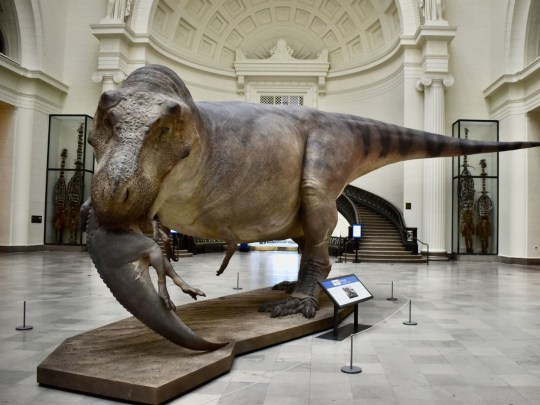
Model of Sue the T.rex eating a baby Edmontosaurus, from the Field Museum, Blue Rhino Studios
Full disclosure before I start this article, I am not a palaeontologist, neither have I kept up with all of the relevant literature to know everything on the topic. But I've seen this debate flair up a few times on paleo twitter in the past, so I'm gonna give you a very shallow overview of the discussion.
Therapod dinosaurs were a very unique type of carnivorous animal. All the active hunting terrestrial carnivores we have today have an upper size limit of maybe a tiger or a bear, and most of those travel on all fours. Large meat eating dinosaurs had different bone structures, metabolisms, and importantly, different prey.
A few times in the past, and again recently, there have been those sceptical of the actual hunting ability of large therapod dinosaurs. Sure they were big enough to kill their prey, but were they fast enough? Had enough stamina? Tyrannosaurus rex had jaws powerful enough to break clean through flesh and bone, but you know what else does? Hyenas, jackals, vultures; scavengers. I am not personally aligned with this hunter-sceptical side of palaeontology, but it is an argument that exists.
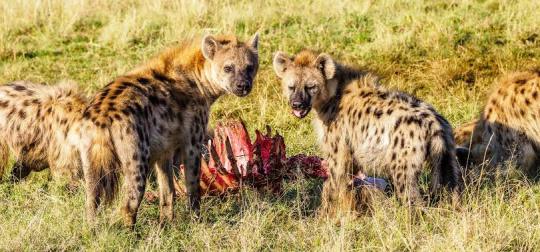
Hyenas scavenging, Credit: The Next Crossing
Long ago there was an ill-informed take that some dinosaurs were too big to walk. Now the current take is that some dinosaurs were too big to hunt. So, with a bit of research, today I'm going to explore both sides of this debate.
Obligate Scavengers
The first part of the argument is usually about how powerful the jaws of Tyrannosaurus are. Its bite could crush bones, and coprolites (fossil poo) from the species has shown remains of bone fragments, confirming that this dinosaur was indeed eating bones. The teeth of dinosaurs more commonly thought of as pursuit predators such as raptors have narrower, blade like teeth, while T.rex had large, thick, banana sized/shaped teeth. So was this dinosaur specialised for mostly rotted carcasses?
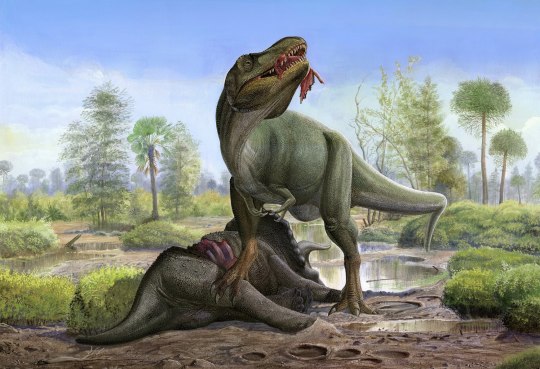
Tyrannosaurus eating a Triceratops, Atrox1 (deviantart)
Tyrannosaurus has also been recently found to have extraordinary senses. It's eyesight is second to none in the dinosaur kingdom and may even rival the visual acuity of today's falcons. And it's sense of smell was amazing too, able to smell blood way beyond even it's visual range. Senses like these are useful for scavengers today who need to travel long distances to find their food. Vultures and condors may travel thousands of kilometres to find a carcass, and like T.rex, their large size means that they can scare off most smaller scavengers from a larger corpse.
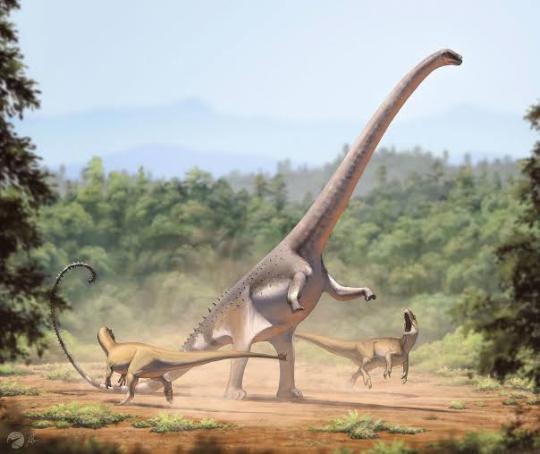
Allosaurus fragilis attack a Diplodocus, Fred Weirum
This last point is more about Allosaurus, who has recently been accused of a scavenging lifestyle too. Although Allosaurus was more lightly built than Tyrannosaurus, and had large powerful claws, it has long been studied to most often preyed on Sauropod dinosaurs, which were many, many times larger than Allosaurus. Allosaurus was thought to be unlikely to be able to take down a Sauropod on its own, and its skull is not as robust as most large therapods its size. Sauropod dinosaurs were truly gigantic, and have been studied to move in herds, so perhaps it was just that Allosaurus followed these herds, and when one died, that's enough meat to sustain even a family of Allosaurus for weeks!
Active Hunters
While it's easy to find fossil evidence of bones being damaged while the animal is dead, evidence of the animal being hunted is not as easy. BUT it can be found. Many prey species dinosaurs have evidence of bone scar tissue, meaning that the animal was injured, but got better. In some specimens, there are specific markings evident of teeth marks on partially healed bones, or even teeth lodged in the bones. Tyrannosaurus rex teeth markings have been found in multiple specimens, showing that Tyrannosaurus was actively attacking live animals, and sometimes, the prey got away.
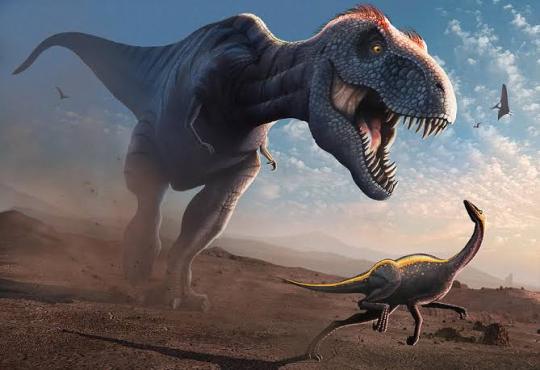
Tyrannosaurus, Mark Garlick
The unusually well adapted senses also point to a predator positive position. Tyrannosaurus' binocular vision is evidence of an animal that needed depth perception, and the only extant animals with true binocular vision are predators. Bone studies have, for a long time, concluded that Tyrannosaurus rex could only walk relatively slowly. But this is a misconception, Tyrannosaurs preferred to walk slowly, and may have travelled most of the time at a more relaxed pace, but it could likely experience short bursts of higher speed. The herbivorous prey items it hunted were not extraordinarily fast either, and a quick dash as an ambush was probably all it took to grab a surprised hadrosaur or ceratopsian.
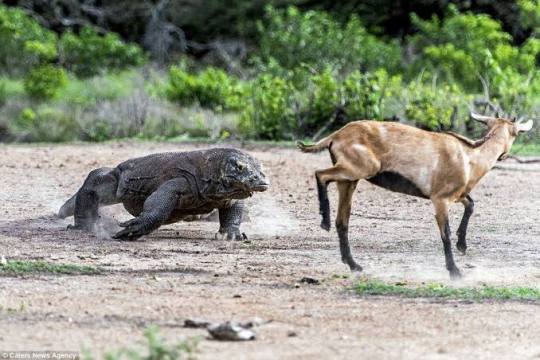
Komodo Dragon hunting a feral goat, Caters News Agency
The hardy teeth of Tyrannosaurus rex may have been well suited for crushing bones, but their overall shape point to damages that could also better injure their prey. Unlike the pointed daggers of most therapods, Tyrannosaurus teeth were deeply serated like a Komodo Dragon's. And Komodo Dragons do not need to kill their prey in one bite either. Their serated teeth are home to bacteria, and once they bite into their prey, the wound festers and bleeds out profusely, until their injury worsens enough that the predator catches up and finishes them off. Palaeontologists have theorised T.rex may have done the same.
Opportunistic Scavengers
The issue with this debate is there seems to be this misconception that it's either one or the other. But what if we consider modern examples of meat eating animals? Sure Hyenas, a well established scavenger can crush bones with its jaws, but you know what else can? Lions, and Tigers, and Bears! Oh my! Crushing bones can help you kill living animals too actually.
And sure Tyrannosaurus rex has shown evidence of scavenging on the carcasses of long dead animals, and Allosaurus has been discussed reaping the benefits of a massive Sauropod carcass, but what predator wouldn't pass up on an already dead animal corpse? Big cats, bears, and wolves have been observed countless times reaping the benefits of animals killed by humans, or massive sea mammals or fish that wash up dead on the beach.
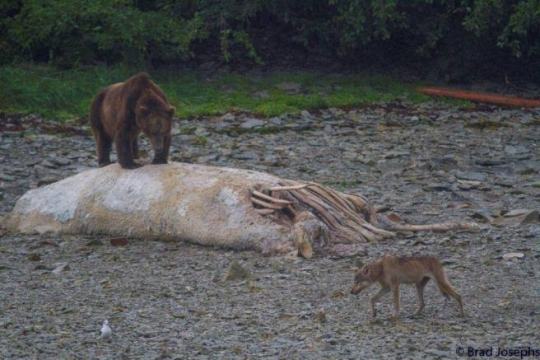
A brown bear and a wolf scavenging on a fin whale carcass, Credit: Brad Josephs
The probable truth of the dinosaur scavenger debate is that most large therapods were capable of taking down some prey items, but would not pass up a large dead dinosaur if the opportunity presented itself. Because much like the corpse of a whale at the bottom of the ocean, a dead dinosaur could sustain a small ecosystem of its own for a while.
Thanks for Reading
This was a very long blogpost, so if you read all the way through it, I much appreciate you taking the time. The topic of predatory dinosaur behaviours is ever evolving as new tests and evidence are presented. The consensus on Tyrannosaurus is currently leaning more toward predator than scavenger, but this study on Allosaurus is still fresh, and despite much of the paleo community opposing this take, evidence against it hasn't been well compiled yet.
If you have any further information you want to present on this topic, I am more than happy to hear it in the Notes, or via inbox. If you know other Palaeontology based topics that you think would be interesting to cover, my inbox and asks are always open.
You can find more articles like this linked in my pinned post.
Credits/Further Reading:
Was Tyrannosaurus rex a Ferocious Predator or a Wimp? (Wilkin & Hone); Frontiers for Young Minds
Allosaurus was not a Carnivorous Predator but a Scavenger during Late Jurassic, Study Finds (Jefferson); The Science Times
Time to slay the T.rex Scavenger Debate (Brian Switek); National Geographic
Tyrannosaurus rex was not a Fast Runner, more a Slow Walker, Simulation shows (David Bressen) Forbes
T.rex: A Hunter AND a Scavenger; The Prehistoric Saga
The Truth About T Rex - Predator or Scavenger; Dangerville - Youtube
#blog#blogpost#palaeontology#dinosaurs#tyrannosaurus#tyrannosaurus rex#allosaurus#allosaurus fragilis#tyrannosaurus scavenger#allosaurus scavenger#dinosaur scavenger
77 notes
·
View notes
Text


#Archovember Day 10 - Ceratosaurus nasicornis
Type species of the Ceratosauria, Ceratosaurus nasicornis was a medium-sized predator from Late Jurassic North America. It was characterized by deep jaws and 3 prominent horns on its head. It also had a ridge of small osteoderms down it’s back, as well as elsewhere across its skin.
Late Jurassic North America seemed to be ruled by a trifecta of theropod apex predators: Torvosaurus, Allosaurus, and Ceratosaurus. There have been multiple studies on how these predators could have coexisted without direct competition, but it was likely due to niche partitioning. Ceratosaurus could have preferred different prey items, and even different parts of a carcass when scavenging. Ceratosaurus had thin, elongated teeth in comparison to the other theropods, and could have even hunted semi-aquatic prey like lungfish, crocodiles, and turtles.
The Morrison Formation is well-known for the sauropods that dominated the region. These include Apatosaurus, Brachiosaurus, Camarasaurus, and Diplodocus. There were also small theropods like Ornitholestes, and ornithischians like Camptosaurus, Dryosaurus, Nanosaurus, the ankylosaur Gargoyleosaurus, and Stegosaurus. There were both aquatic and terrestrial crocodylomorphs like Hoplosuchus, and pterosaurs such as Harpactognathus and Mesadactylus. Ceratosaurus and related species of most of the Morrison Formation’s fauna have also been found in the Lourinhã Formation of Portugal, along with the sauropods Dinheirosaurus and Zby, and the stegosaur Miragaia.
#you can tell I don’t really have much to say about the species when I start talking about ecology lol#Ceratosaurus is still very cool and no matter how much we learn about it it always seems very retro to me#my art#Ceratosaurus#Ceratosaurus nasicornis#Ceratosaurs#theropods#saurischians#dinosaurs#archosaurs#archosauromorphs#Archovember#Archovember2022#drawdinovember#DrawDinovember2022#Dinovember2022#Dinovember#SaritaDrawsPalaeo
89 notes
·
View notes
Note
If you were a dinosaur which dinosaur would you want to be?
I can't remember many but I think a Stegosaurus! That way I can keep mfers off my back and chill and eat grass.
But it'd also be cool to be an Allosaurus since those dudes are big ol scavengers. I would absolutely let a bigger guy kill for me or wait for a tall dude to pass out, I'm too tired to do all that.
Carcharodontosaurus would also be cool. It's got super awesome shark teeth and a funny name that I remember by calling it the Call-the-doctor-a-sarus
#asks#constorfus#i had to reach back into my knowledge from planet dinosaur#which i remember more than the newer documentary#shout out to the Zalmoxes!! my lil beeba wabba
4 notes
·
View notes
Note
The dinos are still a work in progress, but what I’m thinking so far:
All of the color gang are compies. They have the same dumb scavenger pack energy
King is a quetzal. Based on vibes alone, and Purple is an archaeopteryx
Chosen one is a T Rex, Second is an Allosaurus, Dark I want to be some kind of bug megafauna but I might change that… Victim and Alan I’m unsure.
Primal is a Smilodon, and Ballista is a Dilo. Not sure about Agent and Hazard yet (tempted to make Hazard a herbivore)
....dinosaurs ava..................................................
You have no idea how bad it’s gotten. I played Amber Isle which is like a little paleo animal crossing game and have been already cooking up a fluff au and assigning everyone little dinos
15 notes
·
View notes
Note
i find it weird how monster hunter (also skull island in the king kong films) tends to have a higher concentration of carnivores than herbivores, which a.) ignores trophic levels, and b.) ignores that herbivores can be very, very dangerous too if they so please. need a "death world" in fiction? fill it with herbivores that have the attitude of hippos 😂
While it would be nice to have more aggressive herbivores like the blos wyverns (although there is quite a few geovores in the setting) and have the lower tier herbivores fight back like the apceros, the idea of there being “too many carnivores” is actually complete crap.
1: A lot of these large predators likely live in relatively lower population densities than you would think.
2: The world of monster hunter is explicitly way more nutrient rich than ours, and a lot of the herbivores breed like mad.
3: In real life it’s actually not unusual for an ecosystem to have multiple large predators.
Before humans messed up the ecosystem, the African savanna had 5 large predators, 1 large scavenger, 1 large aquatic predator, and several mesopredators.
The Indo-Gangetic Plain had 6 large predators, 1 large scavenger, 1 large aquatic predator, and 2 species of omnivore that occasionally predated herbivores.
Pleistocene North America had 9 to sometimes even 12 large predators.
The Morrison Formation had Allosaurus, Torvosaurus, Ceratosaurus, and Saurophaganax.
A lot of the larger monsters that look like “apex” predators also aren’t.
Pukei-Pukei is a frugivore and fungivore.
Barroth is an insectivore.
Paolumu eats coral eggs.
The giant crabs are likely detritovores.
Bazelgeuse is heavily adapted for scavenging.
The blos wyverns along with duramboros, banbaro, and gammoth are herbivores.
Gravios, uragaan, and dodogama are geovores.
Radobaan is an osteophage.
Deviljho, Ebony Odogaron, Tigrex, and elders are transient species meaning they don’t stick around in one place. Plus Deviljho itself was probably once a gammoth and super large herbivore specialist not unlike sauropod hunters of our world and is now likely going extinct.
Seregios is a nest raider and mesopredator specialist.
Rajang usually goes wherever Kirin are.
And a lot of large predators likely won’t be hunting in the same area at the same time. Plus they specialize for different hunting styles.
And mesopredators still exist in this setting.
The 2005 skull island was actually a pretty well thought out ecosystem that even got its own speculative evolution book.
So contrary to popular belief, a plentiful ecosystem can support several large predators.
This is also ignoring the fact that herbivores will eat meat too.
#also people using emojis at the end of an argument is a pet peeve of mine#like damn you’re really that sure of your argument?#well it’s going to be really embarrassing when you’re proven wrong#ask#questions#ecology#anon#anonymous#monster hunter#speculative zoology#speculative biology#speculative evolution
33 notes
·
View notes
Text
North Africa. 95,000,000 BCE.
The hot midday sun beats down upon a vast tidal plain. Though this region of the world will one day become the Sahara Desert, one of the driest places in the world, in the mid-Cretaceous, it is a lush saltwater swamp, home to all manner of fish, reptiles, and dinosaurs. And some of the dinosaurs that call this swamp home are among the largest creatures to ever walk the earth.
A thunderous footstep heralds the arrival of a Paralititan. Its massive head and neck tower four meters above the tops of the mangrove trees around it. Its legs are thicker than the trunks of the trees themselves, and its body so vast that it plays host to its own self-contained ecosystem.
Normally, Paralititan travels in huge multigenerational herds, roaming the swamplands, stripping them of vegetation. But, this old male is on his own. He has wandered off to die.
The giant’s grey-green flesh seems to pulsate with each thundering footfall. His skin crawls with countless parasitic insects, and even a small pterosaur who has already begun picking at a particularly rancid scab. Although he is still alive, if only just, he is so incomprehensibly ancient that the flesh has already begun to decompose from his bones. Everywhere he goes, the unmistakeable stench of rot follows.
This is something that the local carnivores have picked up on.
A pair of Rugops trail behind the dying sauropod. Though these 6-meter abelisaurs are plenty fierce, their snub-nosed skulls are far too delicate to risk attacking such a mighty adversary. So, Rugops has taken up a niche something like a jackal — harrying weak or dying animals until they succumb to their exhaustion. While it has meant that they do not reach the same large sizes of their cousins in South America, this lifestyle has served Rugops well, and allowed them to survive for millions of years.
The presence of such scavengers is exactly the reason why the dying Paralititan has wandered off on his own. While his brain is diminutive compared to his sixty-ton body, his instincts still tell him to protect the next generation, even in his dying moments. The death of a creature of his size will attract every carnivorous animal for miles. Even with as much flesh is available on his body, it seems almost certain that some of the bloodlust-fueled scavengers will turn on the living herd members. By splitting off from them at the moment of his passing, he greatly reduces that risk.
He stops in his tracks. His great ribcage shudders with his wavering breath. With a final booming gasp, his right foreleg gives way, and the giant collapses. In a great cacophony of splintering trees and splashing water, he falls to the ground, his enormous body shaking the earth when it hits. He is not entirely dead, but he no longer has the strength to stand. The last thing he sees as his synapses fire a final time is the shape of the Rugops pair rushing his fallen body.
The Rugops waste no time in attacking the carcass. The larger male jumps onto the sauropod’s flank, slipping in the accumulated muck before finding his footing. He rips at the thick skin with his toe claws, tearing a hole that he can fit his bulldog-snout into. Once he’s in, he begins his macabre feast. Rugops’ neck is slightly longer than that of its close relatives, so, despite his short jaws, he is still able to reach his head fairly deep into the carcass, and access the more nutritious meat within.
His mate doesn’t waste unnecessary energy creating her own opening. Instead, she simply finds a wound — the same one the pterosaur already opened — and uses that as her entry point.
The two abelisaurs feed for quite some time on the titanosaur’s fetid body. Suddenly, a deep, bassy, almost industrial sound echoes from the trees. They stop eating, putrid flesh still hanging from their jaws, and turn to the direction of the sound.
From out of the brush, another theropod emerges. Nearly three times larger than the Rugops, its scaly hide glittering an iridescent blue. Its enormous boxy head is almost the size of a Rugops’ ribcage, and is packed with teeth the size and shape of steak knives.
Carcharodontosaurus.
It opens its massive jaws, flashing its teeth and emitting another ear-splitting bellow. The Rugops turn to flee, the male slipping once more on the slick hide of the carcass. He falls into the swampy muck with a wet splash, narrowly avoiding the Carcharodontosaurus’ snapping jaws. The two abelisaurs high-tail it away from the scene, as the newcomer claims their quarry.
The Carcharodontosaurus lifts one of its feet, and firmly plants it on the dead Paralititan’s belly, digging in its claws to ensure a steady grip. It leans down, extending its mouth to the widest gape it can muster. The knife-like teeth sink into the meat with almost no effort, and the giant carnivore pulls back its head, slicing out a mammoth hunk of flesh, which it proceeds to swallow whole.
Attracted by the sounds of the commotion, a few more Rugops and a Deltadromeus, a fleet-footed cousin of the Jurassic Allosaurus, have also arrived at the killsite. The Carcharodontosaurus momentarily pauses in its savage gluttony to roar at the smaller carnivores. They turn and run, just like the Rugops pair before, but they do not stray far. Content at their distance, the apex predator resumes its feeding.
There is plenty of food for all of them, but they will have to wait their turn.
57 notes
·
View notes
Note
I’m so sorry the Internet has come to this. You are perfect just the way you are and your interests are absolutely astonishing and wonderful. So, tell me about your favorite dinosaur. What’s it like?
Well Mr sad screaming cat who should get his eyes checks at a vet (cats don't have normal tear ducts. If they are super wet they need a doctor cause of infections) thank you for the ask. Your probably my very first one ever.
As for how the internet is like this, I gotta ask outside society what the hells up. My honest opinion humans needed a few thousand more years in the evolutionary oven if you understand that. Still savanna apes now with guns and money and nukes.
To answer favorite dinosaurs is a very hard question. See we have only 1% perhaps not even 1% of extinct animals in the fossil records because of various factors including acidic ground in jungles, scavengers, time, storms, events, humans, and so on. So perhaps we once had dragons or something similar and now they are gone. Lost in the unkown. However I can answer for the known stuff! I can give a top 4 actually. Ankylosaurus, allosaurus, brachiosaurus, and carnotaurs! Hope this helps. Thanks man....I'm still sad what the heck
7 notes
·
View notes
Text
Alright alright!, here we go!
(Long, long text post after the cut)
First things first, lore time!!
All of this may change overtime as I make adjustments and figure out finer plot details, so don't take everything for being set in stone.
Anyways, my story for the Arcane Order is WAY different than the canon version we were given.
Beginnings
Starting with the main cast, Skrael, Bellroc, and Nari are given a bit of a different dynamic than shown in the show. Instead of just being a vague group of primordial wizards, they were born from the earth itself. Evolution plays out as it does in the modern science books, with the different eras and ice ages. The earliest plant life began about 460 million years ago, that is when Nari first appeared. Nari created new forms of life over a very long stretch of time, including the earliest forms of dinosaurs, and watching those dinosaurs evolve on their own. When they are wiped out by an asteroid, however...
That is when the second Arcane Order member would appear, around the end of the Cretaceous period about 66 million years ago. The recovery period afterwards is when Bellroc comes into the picture for the Arcane Order. They appear while the smaller mammals and rodents are running around and scavenging, trying to survive. (This is where they get their skull headpiece---It's a runt giganotosaurus skull! ((might change to be a juvenile allosaurus skull as well, or a Utah raptor))). From here on Bellroc is just kind of... there. They live throughout history until we get to about... 2 billion years ago.
2 billion years ago is when the first Ice Age began! Which means, you guessed it, Skræl appears! Before this time, however, Bellroc and Nari had grown into a siblings-like bond, with Nari guiding and helping Bellroc around the powers they now wielded.
They hadn't really been meddling in creation very much up to the point that Skræl appears, but afterwards, they start steering the course of the Earth, which includes the beginning of the human race. This is a post for another day, so let's just skip to the part that focuses the most on Skræl!
Skræl's lore / his role in humanity
From here, the timeline can get a bit muddy, since the Inuit and Norse and Norwegien groups of humans I have inspired his looks and lore from appear at about the 13th century, meanwhile toa Wizards dates the Killahead War at the late 12th century. I ask you ignore this hiccup in my storyline, please and thank you!
Anyway, Skræl had taken a liking to the humans who were choosing to live in his harsh arctic environment, specifically the several different Eskimo peoples, which include but are not limited to the eight Inuit groups (credit to this site for the information): The Labradormiut (Labrador), Nunavimmiut (Ungava), Baffin Island, Iglulingmuit (Iglulik), Kivallirmiut (Caribou), Netsilingmiut (Netsilik), Inuinnait (Copper) and Inuvialuit or Western Arctic Inuit (who replaced the Mackenzie Inuit).
Starting with his name, Skræl took his name off of the term that the Old Norse and Icelandic people had for the Inuit tribes, skrælingi or plural skrælingjar. From before this point, Skræl had just been referred to as North Wind by the other members of the Arcane Order and by any mortal/magical creature who knew of him. He chose to be referred to as a male a long time ago as well, simply to ensure that there wasn't much confusion amongst the humans whom he was spending more and more time watching and messing with.
Skræl had been meddling with humans for a very long time, since the first Ice age, and all of the time afterwards that there were ever any humans in his Arctic environment. He had taught the humans many different skills, and was sometimes worshipped alongside other deities by the Old Norse.
He often met with at least one or two elders of an Inuit group every few generations simply to talk and see them off into the next life. (Energy and souls can be reincarnated in my version of Trollhunters, which will leave interesting story options open for future use).
Because of Skræl's open enjoyment of the human race, you can see how I'm setting up the Killahead battle and the way he will react to being asked to meddle with such an important and fragile battle for balance. But that's for later.
Skræl's design inspiration


There are several different observable things to talk about in his design, so lets start with his head dress: the walrus skull.
The reason I decided upon a walrus skull rather than one of a caribou or mammoth or any other great beast is because of the Inuit legend of Sedna, the sea goddess. In the legend, Sedna has her fingers cut off, which then become all of the sea creatures of the oceans, which include things like whales, seals, and walruses. Before this legend came around, though, Skræl had been wearing a scimitar cat skull instead. He switched to a walrus to be more connected to the Inuit.
The second part of his design is his "cloak", which is really just a standard Inuit fur coat that has been cut down the middle like a jacket, and thrown over his shoulders like a cloak. He doesn't wear it like the mortals would because he, as a god, doesn't need to worry about freezing to death. I also just wanted an excuse to show off his tattoos, which may or may not be added. (I still have to find some good and credible resources and references to the meanings behind chest and arm tattoos for the Inuit, so only his face has any right now in the final art I've done for him. the only reason he's kept the two lines across the face is because they **allegedly** mean that he has killed a rather large or memorable whale).
The third part is his pants, which are the common pants of a Norwegian / Viking trousers. They are tied at the waist with rope and wooden/bone beads, because Skræl is just extra like that. The shoes/'shin guards' are also typical boots for Viking age Norwegians *according to my sources*, but I cut them off at the ankle so that he can be bare foot in the snow like the little maniac he is.
Speaking of little, I made him so much larger than he is in the cannon. Skræl stands at about 5'6" when standing up straight, and he's bigger physically, but still extremely lean. He has more of the native features of an Inuit (referenced from old photos off Google).
In a previous ask I sent to @ssiggss, I said that he has braids beneath the hood and skull, but now I'm not sure if I want him to be bald or not. Probably not, just to go the easy route, since I can barely draw loose hair as it is.
He has those little itsy bitsy horns on his head still, too. No lore reason, I just liked them in his canon design.
Skræl (and Bellroc's role) in the battle of Killahead, and a tease at the rest of the story!
Nari is the one who calls the Arcane Order together to discuss the issue of the balance within her domain, and urges them for help. Bellroc and Skræl are don't really agree with the idea of meddling in such a big event, considering they didn't help any of the other previous civilizations during things like the Ice Ages, Aztec empires, or natural disasters like Pompei.
They decline her request, and leave the Wild Wood.
Immediately, Nari is pissed off and tells them to help, but they still decline. Nari gives Morgana her power to be the Mother of Monsters, and meddles in the battle herself.
And then Skræ; and Bellroc disappear...
...until the time of Merlin's death.
Someone ask me about my version of Skrael PLEASE 🙏 I WANT TO RAMBLE ABOUT THIS LOSER
#trollhunters#skrael#toa wizards#trollhunters tales of arcadia#wizards tales of arcadia#arcane order#tales of arcadia#skrael of the north wind#bellroc#bellroc keeper of the flame#nari of the eternal forest#nari#my lore#Jester jokes
19 notes
·
View notes
Text
Australovenator wintonensis

By Scott Reid
Etymology: Southern Hunter
First Described By: Hocknull et al., 2009
Classification: Dinosauromorpha, Dinosauriformes, Dracohors, Dinosauria, Saurischia, Eusaurischia, Theropoda, Neotheropoda, Averostra, Tetanurae, Orionides, Avetheropoda, Megaraptora, Megaraptoridae
Status: Extinct
Time and Place: About 95 million years ago, in the Cenomanian of the Late Cretaceous

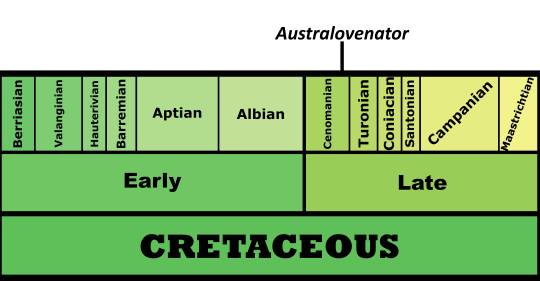
Australovenator is known from the Phimopollenites Pannosus Pollen Zone of the Winton Formation in Queensland, Australia
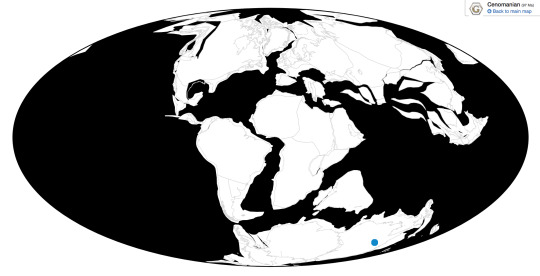
Physical Description: Australovenator was a Megaraptor, a group of fairly mysterious predatory dinosaurs that consistently confuse people since they were first discovered through today. The known parts of Australovenator are rather sparse - limbs and some parts of the torso, and a bit of the tip of the mouth. These elements show an animal with long legs, fairly long arms (for a theropod) with giant hand claws, and a slender jaw. The rest of our understanding of its size and shape is really based on its relatives. It would probably have been 6 meters long and 2 meters tall, weighing only 1,000 kilograms - making it a very lightweight, potentially fast predator. It had extremely flexible hands as well - more flexible than other theropods, almost able to pronate (ie, make “bunny hands”, which is not possible in other theropods). It also had extremely strong feet, built for kicking. Given that it was slender and small, it would have probably been covered in fluffy protofeathers all over its body.

By Ashley Patch
Diet: Australovenator would have been a major predator, able to eat a wide variety of small and medium sized animals in its environment - potentially even larger animals if it was able to work in groups.
Behavior: The behavior of Australovenator is not greatly known, given how mysterious Megaraptorans are as a general group. However, the extremely strong foot bones found with extensive signs of breakage indicates that Australovenator did use its feet to kick at prey, similar to modern emus. This would have greatly bruised and damaged the prey, potentially even breaking bones and causing internal bleeding and organ damage. The extremely flexible arms would have allowed it to use them to manipulate objects, grab at food, and easily claw at prey. In fact, the very large hand claws are notable for the Megaraptorans, since they were originally thought to be the giant foot claws of giant Dromaeosaurs. This ability to claw at and maim prey would have helped Australovenator extensively in taking down prey.
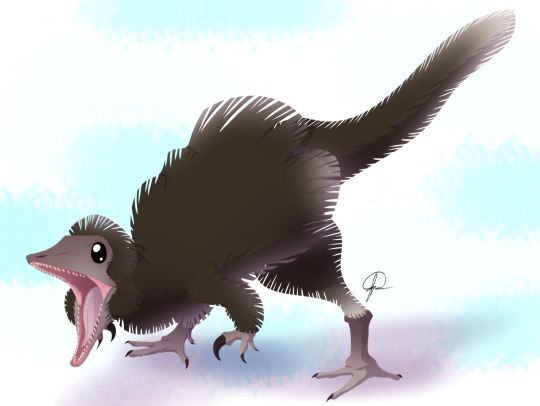
By José Carlos Cortés
Were Megaraptorans social? We aren’t sure. Australovenator was a powerful predator, clearly able to take down other animals in its environment without much help. It may have worked in small groups in order to get food larger than it, such as the sauropod Diamantinasaurus, since there weren't larger predators in its environment. However, there is no direct evidence to support that. Furthermore, in plenty of locations, Megaraptorans are very rare, indicating they wouldn’t have grouped up together much. Still, they usually aren’t the largest predators in a place, so the jury is out for Australovenator. As a dinosaur, it would have probably taken care of its young, though in what way is a question.
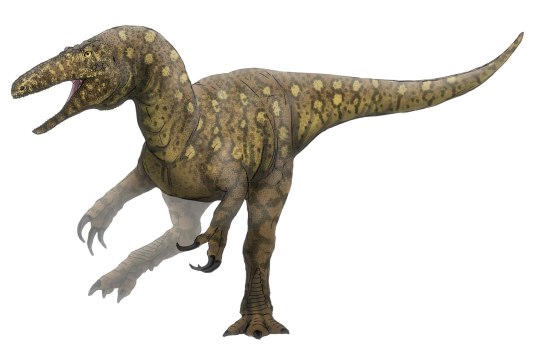
By PaleoEquii, CC BY-SA 4.0
Ecosystem: The Winton Environment was a river basin, next to the former inland Eromanga Sea. This was a highly forested ecosystem with extensive swamps, creeks, lakes, and estuaries leading back to the sea. The dense vegetation made it a hotbed for herbivores, which were all sources of prey for Australoveantor. In fact, Australovenator was found directly with Diamantinasaurus, a 15 to 16 meter long sauropod (indicating that Australovenator may have been scavenging, or worked in a group and was killed by a group member). Other herbivores included the titanosaurs Wintonotitan and Savannasaurus, and the Somphospondylian Austrosaurus. There were a variety of Ornithischians there, though none were named, they may have been Rhabdodonts or Elasmarians; and there was at least one Ankylosaur (probably a basal Ankylosaurid). In addition, there was the large pterosaur Ferrodraco, and the narrow-snouted Crocodylomorph Isisfordia.

By Ripley Cook
Other: Megaraptors like Australovenator are a taxonomical quagmire. They are either closely related to the Carnosaurs - animals like Allosaurus and Giganotosaurus - or to early Coelurosaurs such as the Tyrannosaurs. It’s possible they are Tyrannosaurs, full stop, but an early group of them. Honestly, the question is still up in the air - but they combine a lot of the characteristics of the earlier theropods with the more bird-like ones, which leads to this confusion. Regardless, Australovenator was a very late derived Megaraptor, nested deep within the group.
~ By Meig Dickson
Sources Under the Cut
Agnolin, F. L., M. D. Ezcurra, D. F. Pais and S. W. Salisbury. 2010. A reappraisal of the Cretaceous non-avian dinosaur faunas from Australia and New Zealand: evidence for their Gondwanan affinities. Journal of Systematic Palaeontology 8(2):257-300.
Apesteguía, Sebastián; Smith, Nathan D.; Valieri, Rubén Juárez; Makovicky, Peter J. (2016-07-13). "An Unusual New Theropod with a Didactyl Manus from the Upper Cretaceous of Patagonia, Argentina". PLOS ONE. 11 (7): e0157793.
Benson, R. B. J., M. T. Carrano, and S. L. Brusatte. 2010. A new clade of archaic large-bodied predatory dinosaurs (Theropoda: Allosauroidea) that survived to the latest Mesozoic. Naturwissenschaften 97:71-78.
Brougham, T., E. T. Smith, and P. R. Bell. 2019. New theropod (Tetanurae: Avetheropoda) material from the ‘mid’-Cretaceous Griman Greek Formation at Lightning Ridge, New South Wales, Australia. Royal Society Open Science 6:180826:1-18.
Carrano, M. T., R. B. J. Benson, and S. D. Sampson. 2012. The phylogeny of Tetanurae (Dinosauria: Theropoda). Journal of Systematic Palaeontology 10(2):211-300.
Csiki-Sava, Z., S. L. Brusatte, and S. Vasile. 2016. “Megalosaurus cf. superbus” from southeastern Romania: the oldest known Cretaceous carcharodontosaurid (Dinosauria: Theropoda) and its implications for earliest Cretaceous Europe-Gondwana connections. Cretaceous Research 60:221-238.
Hendrickx, C., and O. Mateus. 2014. Abelisauridae (Dinosauria: Theropoda) from the Late Jurassic of Portugal and dentition-based phylogeny as a contribution for the indentification of isolated theropod teeth. Zootaxa 3759(1):1-74.
Hocknull, S. A., M. A. White, T. R. Tischler, A. G. Cook, N. D. Calleja, T. Sloan, and D. A. Elliot. 2009. New mid-Cretaceous (latest Albian) dinosaurs from Winton, Queensland, Australia. PLoS ONE 4(7):e6190:1-51.
Holtz, Thomas R., Jr.; Molnar, Ralph E.; Currie, Philip J. (2004). Weishampel, David B.; Dodson, Peter; Halszka, Osmólska (eds.). The Dinosauria (2nd ed.). Berkeley: University of California Press. pp. 71–110.
Leahey, Lucy G.; Salisbury, Steven W. (June 2013). "First evidence of ankylosaurian dinosaurs (Ornithischia: Thyreophora) from the mid-Cretaceous (late Albian–Cenomanian) Winton Formation of Queensland, Australia". Alcheringa: An Australasian Journal of Palaeontology. 37 (2): 249–257.
Molnar, Ralph E.; Flannery, Timothy F.; Rich, Thomas H.V. (1981). "An allosaurid theropod dinosaur from the Early Cretaceous of Victoria, Australia". Alcheringa. 5 (2): 141–146.
Novas, F. E.; Agnolín, F. L.; Ezcurra, M. D.; Canale, J. I.; Porfiri, J. D. (2012). "Megaraptorans as members of an unexpected evolutionary radiation of tyrant-reptiles in Gondwana". Ameghiniana. 49 (Suppl): R33.
Pentland, Adele H.; Poropat, Stephen F.; Tischler, Travis R.; Sloan, Trish; Elliott, Robert A.; Elliott, Harry A.; Elliott, Judy A.; Elliott, David A. (December 2019). "Ferrodraco lentoni gen. et sp. nov., a new ornithocheirid pterosaur from the Winton Formation (Cenomanian–lower Turonian) of Queensland, Australia". Scientific Reports. 9 (1): 13454.
Porfiri, Juan D.; Novas, Fernando E.; Calvo, Jorge O.; Agnolín, Federico L.; Ezcurra, Martín D.; Cerda, Ignacio A. (2014). "Juvenile specimen of Megaraptor (Dinosauria, Theropoda) sheds light about tyrannosauroid radiation". Cretaceous Research. 51: 35–55.
Poropat, S.F.; Mannion, P.D.; Upchurch, P.; Hocknull, S.A.; Kear, B.P.; Kundrát, M.; Tischler, T.R.; Sloan, T.; Sinapius, G.H.K.; Elliott, J.A.; Elliott, D.A. (2016). "New Australian sauropods shed light on Cretaceous dinosaur palaeobiogeography". Scientific Reports. 6: 34467.
Salisbury, S. W., A. Romilio, M. C. Herne, R. T. Tucker, and J. P. Nair. 2016. The Dinosaurian Ichnofauna of the Lower Cretaceous (Valanginian–Barremian) Broome Sandstone of the Walmadany Area (James Price Point), Dampier Peninsula, Western Australia. Society of Vertebrate Paleontology Memoir 16. Journal of Vertebrate Paleontology 36(6, suppl.):1-152.
Tucker, Ryan T.; Roberts, Eric M.; Hu, Yi; Kemp, Anthony I.S.; Salisbury, Steven W. (September 2013). "Detrital zircon age constraints for the Winton Formation, Queensland: Contextualizing Australia's Late Cretaceous dinosaur faunas". Gondwana Research. 24 (2): 767–779.
White, M. A.; Cook, A. G.; Hocknull, S. A.; Sloan, T.; Sinapius, G. H. K.; Elliott, D. A. (2012). Dodson, Peter (ed.). "New Forearm Elements Discovered of Holotype Specimen Australovenator wintonensis from Winton, Queensland, Australia". PLoS ONE. 7 (6): e39364.
White, M. A.; Falkingham, P. L.; Cook, A. G.; Hocknull, S. A.; Elliott, D. A. (2013). "Morphological comparisons of metacarpal I for Australovenator wintonensis and Rapator ornitholestoides: Implications for their taxonomic relationships". Alcheringa: An Australasian Journal of Palaeontology. 37 (4): 435–441.
White, Matt A.; Benson, Roger B. J.; Tischler, Travis R.; Hocknull, Scott A.; Cook, Alex G.; Barnes, David G.; Poropat, Stephen F.; Wooldridge, Sarah J.; Sloan, Trish (2013-07-24). "New Australovenator Hind Limb Elements Pertaining to the Holotype Reveal the Most Complete Neovenatorid Leg". PLOS ONE. 8 (7): e68649.
White, M. A., P. R. Bell, A. G. Cook, D. G. Barnes, T. R. Tischler, B. J. Bassam, and D. A. Elliot. 2015. Forearm range of motion in Australovenator wintonensis (Theropoda, Megaraptoridae). PLoS ONE 10(9):e0137709:1-20.
White, Matt A.; Bell, Phil R.; Cook, Alex G.; Poropat, Stephen F.; Elliott, David A. (2015-12-15). "The dentary of Australovenator wintonensis(Theropoda, Megaraptoridae); implications for megaraptorid dentition". PeerJ. 3: e1512.
White, Matt A.; Cook, Alex G.; Klinkhamer, Ada J.; Elliott, David A. (2016-08-03). "The pes ofAustralovenator wintonensis(Theropoda: Megaraptoridae): analysis of the pedal range of motion and biological restoration". PeerJ. 4: e2312.
White, Matt A.; Cook, Alex G.; Rumbold, Steven J. (2017-06-06). "A methodology of theropod print replication utilising the pedal reconstruction of Australovenator and a simulated paleo-sediment". PeerJ. 5: e3427.
Zanno, L. E.; Makovicky, P. J. (2013). "Neovenatorid theropods are apex predators in the Late Cretaceous of North America". Nature Communications. 4: 2827.
#Australovenator wintonensis#Australovenator#Theropod#Megaraptor#Dinosaur#Factfile#Palaeoblr#Dinosaurs#Theropod Thursday#Cretaceous#Australia & Oceania#Carnivore#paleontology#prehistory#prehistoric life#biology#a dinosaur a day#a-dinosaur-a-day#dinosaur of the day#dinosaur-of-the-day#science#nature
339 notes
·
View notes
Note
I want you to talk about dinosaurs
Really? You do?! Hell yeah! Okay, I'm gonna ramble for a bit about dinosaurs so hope you don't mind if you do mind then I'm sorry. This is gonna be a long post, just warning you now.
Okay, so dinosaurs are cool as fuck and I love them so damn much. They’re just so... awe-inspiring. And they’re some of the coolest animals to ever walk the earth. Some were gigantic, with necks that stretched up towards the sky. Others were tiny, maybe even smaller than a chicken. Some had sharp teeth and claws (usually the most memorable ones like T. Rex and such) and some had armor-plated bodies (like the ankylosaurs). I love them all to death and I love how unique and diverse they were! All these fantastic beasts that one day just disappeared forever. I want to see one. I know, that’s crazy, and Jurassic Park shows how that could be a very bad idea, but I want to see one. Not just in the pages of a dinosaur book. I want something I can touch and feel and just see how truly magnificent they were. Dinosaurs like Dilophosaurus, Velociraptor, Parasaurolophus, Edmontosaurus, Albertosaurus and so many more! I want to see them all. How they lived, what they looked like, how they acted...
Tyrannosaurs are some of the biggest carnivorous dinosaurs, with T. Rex being the most famous. No one talks about the other Tyrannosaurs! Albertosaurus, Gorgosaurus, and probably several others yet to be discovered! These were the “tyrant lizards”! They’re big and scary and utterly fascinating! And T. Rex was the king. Tyrannosaurus Rex, or “tyrant lizard king”, was huge! 40 feet long on average and with a powerful bite, I’m willing to bet they were quite a sight to behold! It’s probably the most famous of the dinosaurs, and I can see why! It commands your attention and your curiosity more than most, and it makes for a great movie monster! Those huge teeth and crushing jaws mixed with it’s powerful legs and instinct to hunt make it an exciting creature!
Even so, it was not the biggest carnivorous dinosaur to roam during the Mesozoic! Even Carcharodontosaurus, the “shark-toothed lizard”, was bigger than a T. Rex! Or Giganotosaurus! I suppose T. Rex gained more of a spotlight because it’s easier to say the name, but there are so many other large predatory dinosaurs that deserve attention and public view!
The smaller carnivores are super cool, too! Allosaurus, the “different lizard” (and my personal favorite medium-sized carnivorous dinosaur) had a narrow head and large claws on it’s three-fingered hands. I’ve seen fossils up-close of these guys, and I have to tell you, it’s amazing. It may not be as big as your favorites, but it is an amazing dinosaur! They have horn-like protrusions over their eyes, and a mouth full of razor-sharp teeth. They are absolutely beautiful and fascinating creatures!
And as for Velociraptor, you might know them from Jurassic Park. However, the real velociraptor is not nearly as big as those ones, which stand at about 6 ft. tall. The real velociraptor was about the size of a turkey! At about 2 ft. tall and 6 ft. long, Velociraptor (”speedy/quick thief”) was a tiny terror. They most likely hunted in packs to bring down animals much larger than they are. The sickle-shaped claw on both feet was used to puncture, not to tear. They were quick and effective hunters. They were also intelligent, based on the fact that they had a large brain compared to their body size. I love Velociraptors. I really do. I want to understand how they work, what they looked like, and how they lived.
Then there’s the herbivores! Undoubtedly some of the biggest animals to ever roam the Earth! The largest dinosaur currently on record was the Argentinosaurus (”lizard of Argentina” or “Argentina izard”, etc.), a monstrous titanosaur that was about 120 ft. from head to tail and likely weighed nearly 100 tons (200,000 lbs. or so)! They were huge! bigger than even the biggest land-dwelling animals today! Taller than giraffes, even! And you most likly don’t know the sheer scale of dinosaurs like triceratops or Stegosaurus! I’ve seen a Triceratops skull up-close, and I must tell you it was much bigger tahn I thought it would be! Triceratops was about 30 ft. long, with a neck frill span of about 6 ft. and horns that could reach over 3 ft. long! It was much bigger than your car, to give you some scale! And Stegosaurus is quite a sight even as a fossil! With a length of 21-30 ft. and a height of about 14 ft., this massive dinosaur had a very tiny brain. It’s brain is said to be the smallest brain proportional to body size of any dinosaur (any brain size currently known, that is)! Isn’t that fascinating? I’ve seen them up-close, too, and I can tell you that they have a very small head for such a large animal!
Then there’s hadrosaurs, which are amazing on their own! Look up Parasaurolophus, Lambeosaurus or Iguanodon and you’ll see what I mean! There’s so many more, like Corythosaurus, Oranosaurus, Tenontosaurus, etc.! They were herd animals, staying in large groups and nesting together. There’s even evidence, like in the case of Maiasaura, that they took care of and watched over their young! Most of them were pretty big, but an even more fascinating feature was their crests. These dinosaurs often had large crests on their heads, though their function is still debated. They could have been used to make unique calls or to amplify their calls, or they could have been used to identify each other! It really is interesting to think about it!
Then there’s the real oddballs, such as Psittacosaurus, Saltosaurus, any of the Ankylosaurs, and even dinosaurs like Dilophosaurus (two-crested lizard), Monolophosaurus (one-crested lizard), Spinosaurus, and the Pterosaurs! Ankylosaurs (like Ankylosaurus or Euoplocephalus) were large, heavily-armored reptiles, with Ankylosaurus even having armored eyelids! Their backs were covered in bone plating, and they were often covered in spikes or nodules. Several also had a club of solid bone on the end of their tails! The muscle power, combined with the club, could cause some serious damage! Only the most ferocious or desperate of dinosaurs would dare to try and take on these living tanks! The only way to have an advantage would be to hit it from beneath or to flip it over, which wouldn’t have been easy. Spinosaurus was quite an odd creature. With its odd proportions and dense bones, it was likely quadrupedal to help balance it’s weight. It had large, heavy, hooked claws on its arms and a long skull filled with cone-shaped teeth, perfect for catching slippery fish, but not so good for tearing flesh. They were very top-heavy, and likely walked on their knuckles like an anteater so they didn’t dull down their claws. Then there was the sail. It’s still unknown what exactly this sail was for. It would have made it a bit more difficult to move around, but it may have been used to regulate body temperature or to serve as a display! There’s also a possibility that it had webbed feet! While it may look very weird to us, Spinosaurus was perfectly adapted to life by the water! Dense bones helped keep it submerged, likely with only it’s nose and eyes above the water (like a crocodile), while it’s teeth and claws helped it hunt fish and other water-dwelling creatures! Basically, all of that weirdness had a very unique and cool purpose! Spinosaurus looked very different from the Spinosaurus in Jurassic Park 3, but it’s still just as cool! Then there’s the Pterosaurs. Some as small as bats or small birds, and the largest being about the same size as a small plane! They fill a specific role it the prehistoric world, later filled by birds! Pterodactyl was not a dinosaur, but Pterodactylus was! The largest of these creatures, standing taller than a giraffe and with a wingspan of about 50 ft, was Quetzalcoatlus. It’s thought they were likely scavengers, like vultures, but may have occasionally caught their own food. Some Pterosaurs would travel long distances often to reach their nesting grounds, while others did not. Like bats, Pterosaur’s wings were made up of a skin membrane stretched between the body and the elongated finger making up the outer edge of the wing. They were light-weight animals, and everything about them was evolved to make them perfect and graceful fliers, though this likely made them very awkward when on the ground.
Then there’s also the prehistoric marine reptiles! Mosasurus, Tylosaurus, Plesiosaurs, Pliosaurs, Ichthyosaurs, and many more! Ichthyosaurs were basically like the dolphins of the prehistoric oceans! They had almost fish-shaped bodies and long, usually toothed beaks. I’d definitely recomend looking up a picture of these guys! They breathed air like all reptiles and did not have gills. All prehistoric marine reptiles breathed air, similar to today’s sea turtles or sea snakes. Mosasaurus was a large predatory marine reptile, with lots of teeth and a long, slender body with a powerful paddle-like tail and four flippers instead of legs and feet. Tylosaurs are similar (I think... if I remember correctly...), though if I remember correctly, not all of them had long tails, and some had large powerful flippers instead of a long tail. Plesiosaurs had a very long neck, a small head with interlocking teeth (essentially creating a fish cage), and a large, slender body with a very short tail an four large, powerful flippers. Some of these animals preyed upon other marine reptiles and larger marine creatures, while others only ate fish and other small marine creatures. They’re all so unique and look nothing like anything we have today! And there’s so many more that I haven’t even talked about that I would seriously encourage checking out!
I’ve loved dinosaurs for as long as I can remember. I even still have my first dinosaur book! It’s a neat picture book full of pictures of dinosaur sculptures and dinosaur names! I have a sauropod plushie that I’ve had forever! He’s a little beat up and has a few places where he’s been sewn back up, but I still have him! And I have a model Kronosaurus that I can show you if you’d like! I love dinosaurs so damn much, and I really want to know more about them! I want to know what colors they were and what their skin feels like! I want to see one someday, but until then, fossils are just as good! I FUCKING LOVE DINOSAURS AND THEY’RE SO COOL AND I WANT TO PET ONE SO BAD!
Anyway, that’s my long, rambling post about dinosaurs! I’m glad I got that out! Hope I didn’t confuse you or bore you. I just really love dinosaurs and get super excited and disorganized when I talk about them! I love them so much and they’re really amazing once you start learning about them!
3 notes
·
View notes
Text
tier of dickhead dinosaurs from ‘actual satan to will tolerate them sometimes’ as written by chauncey:
Carnataurus: actual satan. Dumbass short snouted ugly satan ass literally the worst push them off a cliff. its always on sight
Allosaurus: Tiny dick energy. Captain prick. Bigass ugly ass bully chicken leg looking motherfucker. Hate him. Burn in the fires of hell. Stealing my fucking food ass bitch.
Utahraptor: Big dumb jock. Just trying to be bigger than us bald motherfucker. Can’t even keep feathers. Egg head bitch who doesn’t know shit. Trying to lap up our success. Idiot.
Ceratosaurus: Not super terrible but still annoying. Literally follows us everywhere. Constantly needing some sort of validation. You play hide and seek for a living you dipshit. Get some actual talent. Stop being a codependent asshole.
T-rex: I tolerate you. Big bulky and dumb with tiny arms. We’re fine as long as you don’t try and scavenge after me your prey is 10x bigger than mine. Just go eat the big fucks and leave me alone and were good.
5 notes
·
View notes